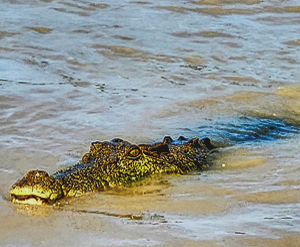Kakadu … living cultural landscape … one of largest national parks in Australia … over 20,000 square kilometres (2 million hectares) – nearly half-size of Switzerland. Park is dual World Heritage-listed for its outstanding natural and cultural values.
The Crocs
Among natives living in Kakadu are 10,000 crocodiles … about 10% of all crocs in Northern Territory !
2 types of crocs reside … freshwater crocs, “salties” or saltwater crocs.
Both are equally dangerous – don’t believe otherwise !
Freshwater crocs, grow up to 3 metres long, have narrow snout, single row of 4 large scutes (bony plates) behind heads; salties, however, can grow up to 6 metres, weigh over 1 tonne, have broader snout, no scutes.
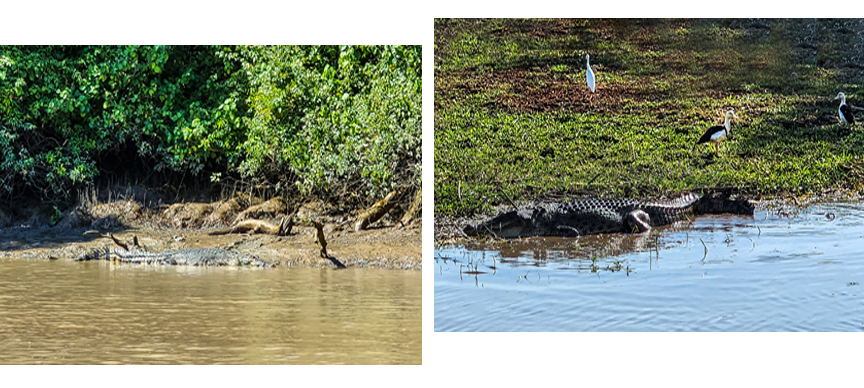
Where to see them
Forget about taking a peek in nearest billabong, waterhole or river – they are not easy to spot. By the time you notice them, it may not end well …
There is no such thing as ‘swimming with or near crocs’ … these are prehistoric predators …
And You Are Meat.
Safest way to see crocs is on commercial cruise – with professionals who know how to handle crocs on daily basis.
There are cruises on East Alligator River or Yellow Water (Ngurrungurrudjba) Billabong, where you are in relative safety of boat, observing natives (crocs) along river side, swimming close-by, watching …
Best time is dry season … as shrinking water bodies encourage crocs to concentrate in smaller areas.
Remember, where there is water; there might be crocs.
Exercise extreme caution near rivers, billabongs … pay attention to croc warnings.
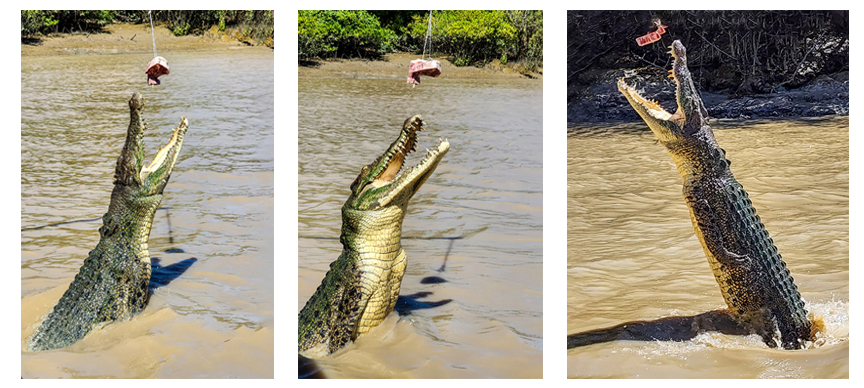
Croc Behaviour
Saltwater crocs mostly feed on fish, maybe turtles, birds, large land animals like wallabies, dogs, pigs, horses, cows or buffalo.
Freshwater crocs eat fish, small animals like frogs, lizards, snakes, rats, bats, birds, insects.
Reptiles like crocs rely on environment to regulate body temperatures – hence basking in sun, with jaws wide open to avoid brain overheating, present threatening disposition; is often sighted as you float along river.
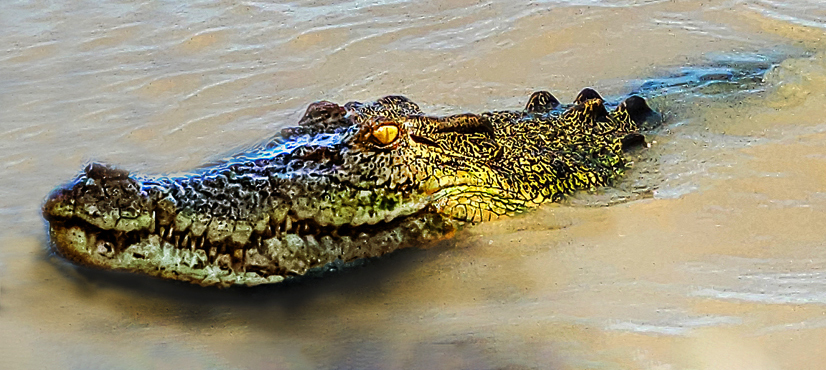
Male crocs are extremely territorial – constantly compete to maintain boundaries. Often defeated croc may travel hundreds of kilometres to search for new territory.
Scientific names for saltwater croc is ‘Crocodylus Porosus’ and for freshwater croc, ‘Crocodylus Johnston’.
Estuarine saltwater crocs are Kakadu’s fiercest predators; often gather around Cahills Crossing causeway to feed on mullet and barramundi when tide pushes in and over road leading into Arnhem Land. This seasonal phenomenon occurs in late dry season, when floodplains, other waterways dry out, freshwater flow from headwaters of East Alligator River decreases.
There are 3 viewing platforms overlooking directly to Cahills Crossing – safest vantage point to view crocs.
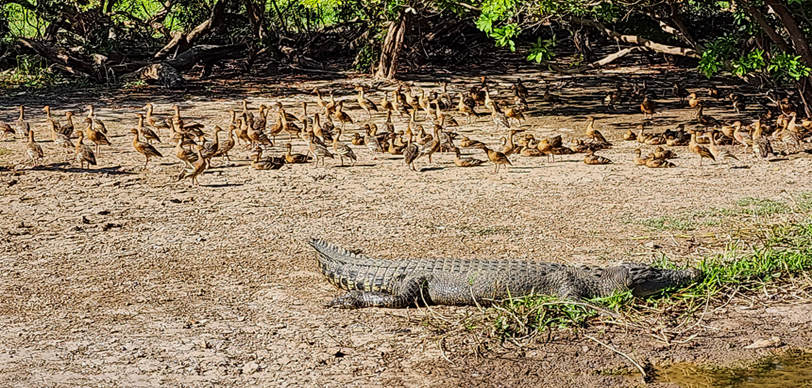
When to see Crocs
Best months to experience this croc spectacular is July to October/November; peaking in September till wet season commences.
Croc population increases dramatically during this time – relative to fish or prey biomass as large tides push muddy water and mullet upstream.
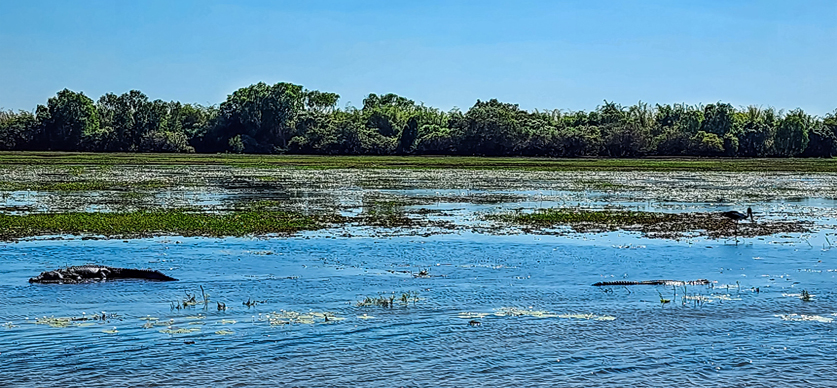
Do you know that over 50 crocs have been counted in 400metre stretch of river between Cahills Crossing and East Alligator River upstream boat ramp around this time?
Normal croc density is about 5-9 crocs per kilometre.
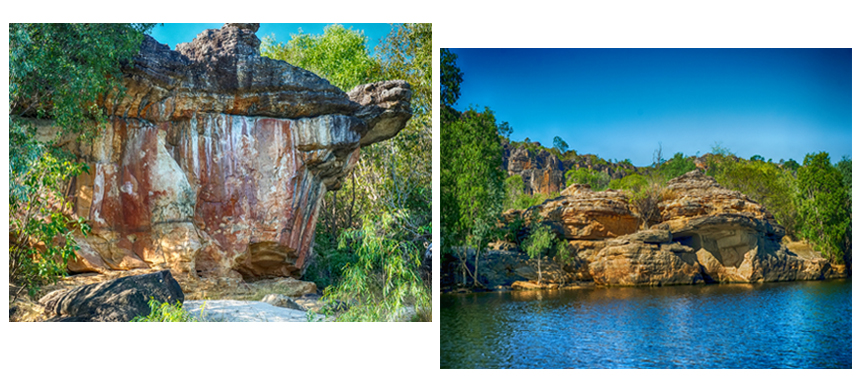
Guluyambi Cultural Cruise
Saltwater crocs are an integral part of daily cultural life of Traditional Owners. Respect of cultural nuances is expected from visitors – do not cross causeway on foot and stay away from water’s edge.
Guluyambi Cultural Cruise offers unique boat tour on East Alligator River; view pristine wilderness of World Heritage landscape … leisurely cruise upstream … observing abundant birdlife, small wild animals such as wild boar, bats. An Aboriginal guide gives insights into traditional culture, local mythology, traditional uses for plants, bush survival skills.
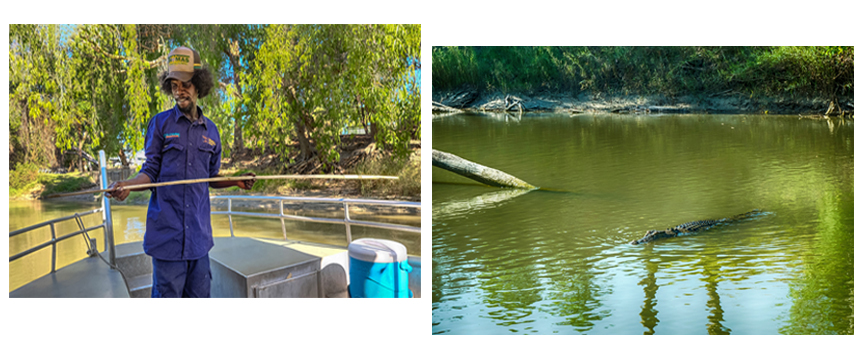
Yellow Water Billabong Croc Spotting
Sunset at Yellow Water Billabong is also good time for croc spotting – walk on boardwalk, platform to watch crocs glide through waters … or sunning on banks of wetlands.
There is also Yellow Water Wetland cruise where you can observe crocs in original wetland habitat – either basking in sun’s warmth or blending into environment on log or muddy banks … watching … observing …
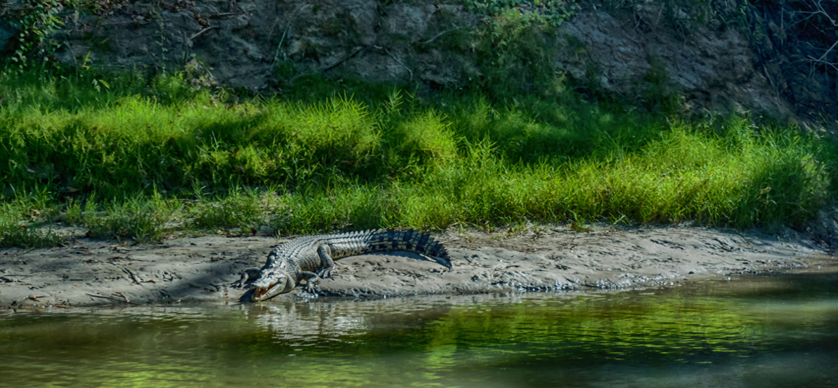
Facts about Saltwater Crocs
Saltwater crocs are one of oldest creatures on Earth. First appeared over 240 million years ago; around same time as dinosaurs. Whilst others have evolved, crocs stuck to same structure for last 200 million years.
World’s biggest reptile, crocs can live up to 70 years, size of 5 metres length – though largest croc found in 1980s measured in at over 6 metres (20 feet). Baby crocs weigh about 60gm (0.13lbs) when born; adult males – about 1 tonne (2,205lbs) weight.
Crocs lay up to 50 eggs in nests built along river banks. 3 months incubation, baby crocs are hatched – sex determined by temperature of nest. Only 1% of hatchlings survive into adulthood.
With about 68 razor-sharp teeth, exerting about 2 tonne pressure in single bite – if teeth break off in process, they simply grow new ones !
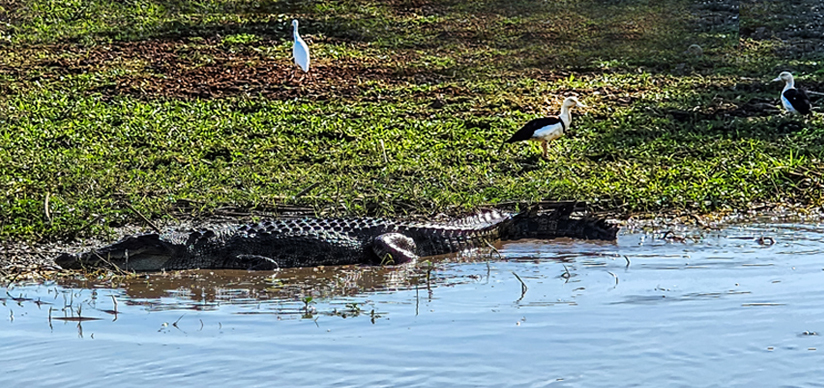
Do you know that crocs can only eat above ground ?
Though crocs might strike underwater; they cannot swallow below surface. Crocs lift their prey above water to eat.
Do you also know that saltwater crocs swim up to speeds of 10km per hour, run on land up to 11km/hour in short sharp bursts?
You simply cannot outrun crocodiles when they are hungry !
Crocs’ endurance is definitely noteworthy – they can travel up to 900km (560miles) in one go – amazing !
Crocs range from dark green, grey, brown with white underbellies – blends perfectly with natural murky brown tropical waters – perfect camouflage.
Crocs sleep with one eye open … unihemispheric sleeping – shuts down half brain only … keep other alert to nearby danger. Uhmmm …
Crocs have a ‘Death Roll’ move hunting behaviour – rolling rapidly in water to overcome prey, as their teeth is designed for gripping, not ripping.
Historically, crocs were hunted to near extinction – in 1871, crocs became protected species – current population estimated around 150,000 in the wild.
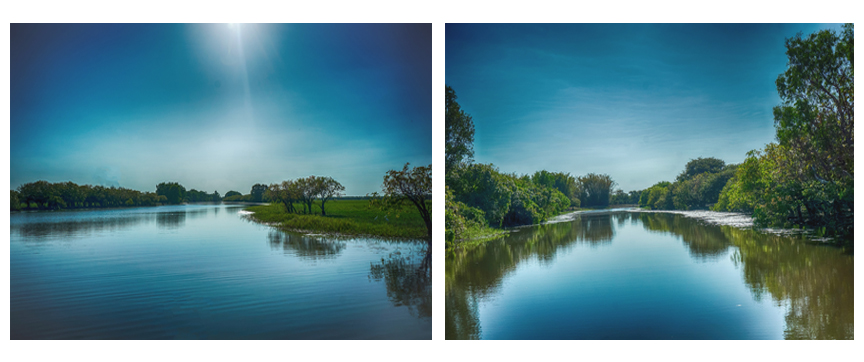
Final Words
Saltwater, freshwater crocodiles are lethal predators. Respect them in their environment.
They don’t usually look for human preys … unless provoked or boundaries violated.
Intimidating, scary reptiles … best seen in safety of professional cruise boats … afar … appreciated behind camera lenses.
Big or small, crocodiles are amazing creatures who live side by side with other wild life, on muddy river banks all over Kakadu National Park.
Definitely an unforgettable experience !
